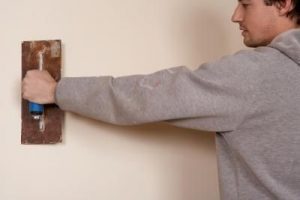

The best techniques for this purpose are those that use at least 2 colors for an effective play on textures: color-washing, lime-washing, glazing, rubbing, and sponging. If you do decide to skim coat or paint the wallpaper, be sure to use an oil based slow drying primer first because anything water based will reactivate the paste. And unless you have some major holes in the walls, you don’t even need to do any repairs to the walls, because then incorporated into a faux finish pattern, all the dents, scratches and uneven spots will actually add to the chic and authenticity of the finish.

What if you could use those unsightly wall flaws to your advantage? Well, with painting techniques, you can! With faux painting, you can deliberately highlight and enhance any surface “defects” and turn them into benefits, where they will now look intentional, and play an important part in creating a lived-in, distressed or antique look and feel. Play It Up- With Faux Painting Techniques: You can also use texture stencils to create raised abstract or theme-based designs on the surface, and some people even use their babies’ little hands and feet to leave cute, adorable imprints on the walls. And if you have seen some wall texture style and didn’t care much for the look, think again- there are dozens of ways to texture a wall, so no matter what your preferences are, you are bound to find the look you’ll like.ĭepending on the technique, materials, and tools used in the process, you can create a mildly, moderately, or heavily textured surface in any color and finish-brushes, wide knifes, whisk brooms, rags, sponges and even your fingers are all great tools to create a unique, one-of-a-kind pattern. With textured wall painting techniques, not only can you hide many surface flaws, but you will also add a decorative value to your home at the same time. If your walls are really ugly and you aren’t married to the idea that they have to be flat and smooth, using a textured pain may be a better alternative to skim coating (you will still need to deeply gouged spots first but you won’t have to make it perfect). After the repairs and surface prep, follow it up with 2 coats of quality flat paint for a velvet-like finish that will help to further blend in any minor imperfections still left, and make them “disappear”. This is a very labor intensive, multi-step process that requires skill and is left better to the professionals if you want really smooth results- arms with some caulk, compound and his tools, and experiences house painting contractor can create what seems like magic and make the surfaces look like new again. Depending on the extent of the damage, some walls may need to be skim coated entirely, to create a new surface. Usually, a skim coat is followed by painting, which could incur the final cost of the project. On average, skim coating the ceiling of a room can range between 300 to 450, which translates to a range of 1 to 1.50 per square foot. Never underestimate the power of a good, thorough surface preparation. This method drastically cuts down on the removal expenses that other methods do. Applying a skim coat of joint compound creates a more uniform surface and minimizes the differences.

One of the following 3 ways will surely work for your situation.Įven if the walls look really bad to you, chances are they can still be restored and made smooth. These differences can show even when the surface is painted. In fact, the right wall painting technique offers you a faster, cheaper, and easier way to handle the problem. Wall flaws can be a real eyesore, but drywall installation or replacement is not the best or only solution available. That’s because old and damaged walls require a special wall painting technique in order to cover up the surface imperfections- be it loose and cracking plaster or gouged and peeling drywall. have damaged your walls, trying to cover up the damage never seems to be an easy task. Continue doing this all over the wall until you think you have covered all dents and scuffs.Whether you, your family, pets, etc. You will want to keep the trowel at a steep angle because you are only filling the dent and marks. Spr ead some filler on one side of your trowel and spread it over the wall. Grab your self some good interior filler and a plastering trowel. Then interior filler can make it much smoother. If there is plaster on your walls and you want to make it smoother for painting, or maybe you have removed wallpaper and your wall is not smooth enough for painting.

The spreading tool is provided for super smooth walls.A much cheaper solution to smooth walls.It’s easy to use and will offer the best benefit when compared to the other methods listed in this hot-to smooth walls guide. This solution is for beginners or homeowners who have never plastered before. This is by far the easiest way to get your walls smooth and ready for painting or wallpapering.


 0 kommentar(er)
0 kommentar(er)
